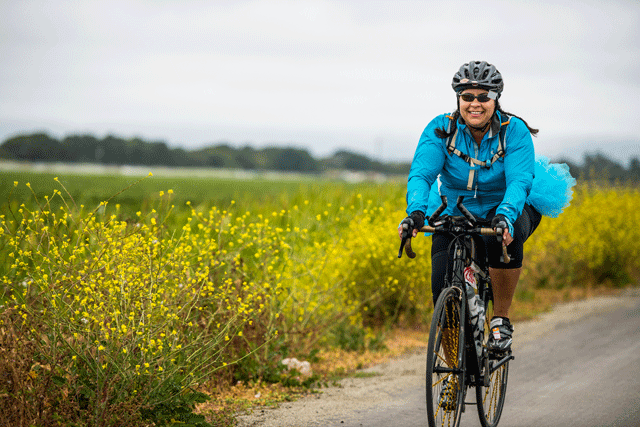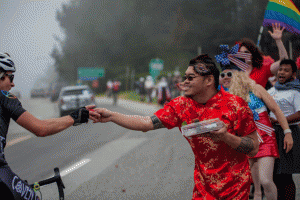AIDS Life Cycle Ride passes through Paso Robles

An AIDS/Life Cycle participant rides through the countryside between San Francisco and Los Angeles. This year’s ride began Sunday. Photo courtesy of AIDS/Life Cycle
Ride will pass through Paso Robles on Tuesday
Thousands of cyclists and support crew will stop in Paso Robles on Tuesday, June 2, on their journey from San Francisco to Los Angeles for the 14th AIDS/Life Cycle ride. The annual ride started Sunday, May 31, and ends Saturday, June 6, and is expected to raise a record of $15.5 million to San Francisco AIDS Foundation and the HIV/AIDS-related services of the Los Angeles LGBT Center and will have 3,200 participants between 18 and 86 years of age from 46 states, the District of Columbia and 20 foreign countries.

A supporter shares a piece of fruit of a rider on the AIDS/Life Cycle ride. Photo courtesy of AIDS/Life Cycle
The fully supported, 545-mile ride, is not a race. The purpose of it, besides raising funds, is to raise awareness about the ongoing HIV/AIDS epidemic. The money raised will go to services such as HIV testing and screenings for other sexually transmitted infections, HIV medical care, prevention services and more.
“Through their commitment, AIDS/Life Cycle participants make a bold statement that there is much work to be done in the fight against HIV/AIDS,” San Francisco AIDS Foundation CEO Neil Giuliano said. “Because of their efforts, we are able to provide all of our direct services for HIV prevention and care for free to more than 15,000 clients every year. We are also able to give people living with HIV/AIDS a powerful voice at all levels of government through our robust and effective advocacy efforts. Right now, we’re working with local officials and health care organizations to build a plan to end HIV transmission in our city, and AIDS/Life Cycle plays a critical role in making that goal a reality.”
According to the release, in the seven days that the riders are on the road, more than 1,000 people in the U.S. will become infected with HIV. One out of five people living with HIV in the country do not know they have it.
“Each week, about 100 Californians become HIV-positive — nearly half of them in Los Angeles,” Los Angeles LGBT Center CEO Lorri L. Jean said. “Alarmingly, the infection rate among gay and bisexual men, particularly among men of color, is still on the rise. We’re making great strides in caring for those living with the disease, but we must prevent new infections. AIDS/Life Cycle not only supports the leading edge medical services of our Jeffrey Goodman Special Care Clinic, it supports our prevention programs, including PrEP — pre-exposure prophylaxis — for those at risk of HIV infection.”
According to Caltrans, the cyclists will use portions of the state highway system during the daytime hours in the following locations:
- Sunday, May 31: Cyclists left San Francisco and arrived in Santa Cruz County
- Monday, June 1: Riders left Santa Cruz County on Highway 1 and continue southbound on Highway 101 to King City
- Tuesday, June 2: Riders will leave King City and use a portion of southbound Highway 101 before reaching Paso Robles
- Wednesday, June 3: Cyclists will use Highway 46 West to Highway 1 south toward Pismo Beach before reaching Santa Maria
- Thursday, June 4: Cyclists will leave Santa Maria towards Highway 1 and continue south ending the day near Highway 246 in Lompoc
- Friday, June 5: Riders will leave Lompoc and use Highways 246, 1 and 101 through southern Santa Barbara County before entering Ventura County.
Caltrans reminds motorists to move over and slow down when driving through highway construction zones in order to keep the cyclists safe on their 545-mile journey.






















